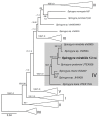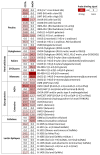Induction of Conjugation and Zygospore Cell Wall Characteristics in the Alpine Spirogyra mirabilis (Zygnematophyceae, Charophyta): Advantage under Climate Change Scenarios?
- PMID: 34451785
- PMCID: PMC8402014
- DOI: 10.3390/plants10081740
Induction of Conjugation and Zygospore Cell Wall Characteristics in the Alpine Spirogyra mirabilis (Zygnematophyceae, Charophyta): Advantage under Climate Change Scenarios?
Abstract
Extreme environments, such as alpine habitats at high elevation, are increasingly exposed to man-made climate change. Zygnematophyceae thriving in these regions possess a special means of sexual reproduction, termed conjugation, leading to the formation of resistant zygospores. A field sample of Spirogyra with numerous conjugating stages was isolated and characterized by molecular phylogeny. We successfully induced sexual reproduction under laboratory conditions by a transfer to artificial pond water and increasing the light intensity to 184 µmol photons m-2 s-1. This, however was only possible in early spring, suggesting that the isolated cultures had an internal rhythm. The reproductive morphology was characterized by light- and transmission electron microscopy, and the latter allowed the detection of distinctly oriented microfibrils in the exo- and endospore, and an electron-dense mesospore. Glycan microarray profiling showed that Spirogyra cell walls are rich in major pectic and hemicellulosic polysaccharides, and immuno-fluorescence allowed the detection of arabinogalactan proteins (AGPs) and xyloglucan in the zygospore cell walls. Confocal RAMAN spectroscopy detected complex aromatic compounds, similar in their spectral signature to that of Lycopodium spores. These data support the idea that sexual reproduction in Zygnematophyceae, the sister lineage to land plants, might have played an important role in the process of terrestrialization.
Keywords: Spirogyra; alpine region; cell wall; conjugation; sexual reproduction; streptophyte; zygospore.
Conflict of interest statement
The authors declare no conflict of interest.
Figures







Similar articles
-
Zygospore formation in Zygnematophyceae predates several land plant traits.Philos Trans R Soc Lond B Biol Sci. 2024 Nov 18;379(1914):20230356. doi: 10.1098/rstb.2023.0356. Epub 2024 Sep 30. Philos Trans R Soc Lond B Biol Sci. 2024. PMID: 39343014 Free PMC article. Review.
-
Temperature- and light stress adaptations in Zygnematophyceae: The challenges of a semi-terrestrial lifestyle.Front Plant Sci. 2022 Jul 19;13:945394. doi: 10.3389/fpls.2022.945394. eCollection 2022. Front Plant Sci. 2022. PMID: 35928713 Free PMC article. Review.
-
Zygospores of the green alga Spirogyra: new insights from structural and chemical imaging.Front Plant Sci. 2022 Dec 6;13:1080111. doi: 10.3389/fpls.2022.1080111. eCollection 2022. Front Plant Sci. 2022. PMID: 36561459 Free PMC article.
-
Zygospore development of Spirogyra (Charophyta) investigated by serial block-face scanning electron microscopy and 3D reconstructions.Front Plant Sci. 2024 Mar 14;15:1358974. doi: 10.3389/fpls.2024.1358974. eCollection 2024. Front Plant Sci. 2024. PMID: 38559764 Free PMC article.
-
Cell wall characteristics during sexual reproduction of Mougeotia sp. (Zygnematophyceae) revealed by electron microscopy, glycan microarrays and RAMAN spectroscopy.Protoplasma. 2021 Nov;258(6):1261-1275. doi: 10.1007/s00709-021-01659-5. Epub 2021 May 11. Protoplasma. 2021. PMID: 33974144 Free PMC article.
Cited by
-
Zygospore formation in Zygnematophyceae predates several land plant traits.Philos Trans R Soc Lond B Biol Sci. 2024 Nov 18;379(1914):20230356. doi: 10.1098/rstb.2023.0356. Epub 2024 Sep 30. Philos Trans R Soc Lond B Biol Sci. 2024. PMID: 39343014 Free PMC article. Review.
-
Temperature- and light stress adaptations in Zygnematophyceae: The challenges of a semi-terrestrial lifestyle.Front Plant Sci. 2022 Jul 19;13:945394. doi: 10.3389/fpls.2022.945394. eCollection 2022. Front Plant Sci. 2022. PMID: 35928713 Free PMC article. Review.
-
The extracellular matrix of green algae.Plant Physiol. 2023 Dec 30;194(1):15-32. doi: 10.1093/plphys/kiad384. Plant Physiol. 2023. PMID: 37399237 Free PMC article. Review.
-
Zygospores of the green alga Spirogyra: new insights from structural and chemical imaging.Front Plant Sci. 2022 Dec 6;13:1080111. doi: 10.3389/fpls.2022.1080111. eCollection 2022. Front Plant Sci. 2022. PMID: 36561459 Free PMC article.
-
Search for evolutionary roots of land plant arabinogalactan-proteins in charophytes: presence of a rhamnogalactan-protein in Spirogyra pratensis (Zygnematophyceae).Plant J. 2022 Feb;109(3):568-584. doi: 10.1111/tpj.15577. Epub 2021 Nov 26. Plant J. 2022. PMID: 34767672 Free PMC article.
References
Grants and funding
LinkOut - more resources
Full Text Sources

